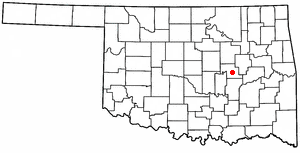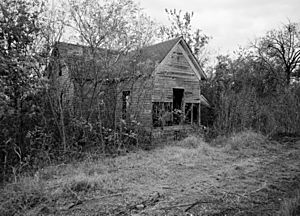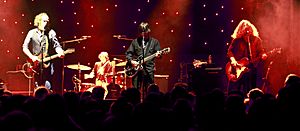Woody Guthrie facts for kids
Quick facts for kids
Woody Guthrie
|
|
|---|---|
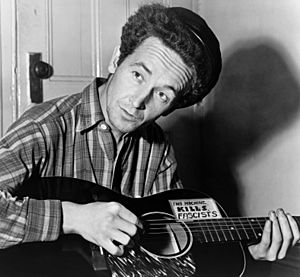
Guthrie with a guitar labeled "This machine kills fascists" in March 1943
|
|
| Born |
Woodrow Wilson Guthrie
July 14, 1912 Okemah, Oklahoma, U.S.
|
| Died | October 3, 1967 (aged 55) New York City, U.S.
|
| Spouse(s) |
Mary Jennings
(m. 1931; div. 1940)Marjorie Greenblatt
(m. 1945; div. 1953)Anneke Van Kirk
(m. 1953; div. 1956) |
| Children | 8, including Arlo and Nora |
| Musical career | |
| Genres |
|
| Occupations |
|
| Instruments | |
| Years active | 1930–1956 |
| Military career | |
| Allegiance | United States |
| Service/ |
United States Merchant Marine United States Army |
| Years of service | 1943–1945 (Merchant Marine) 1945 (Army) |
| Battles/wars | World War II |
| Awards | Merchant Marine Atlantic War Zone Medal Merchant Marine World War II Victory Medal American Campaign Medal World War II Victory Medal |
Woodrow Wilson Guthrie (July 14, 1912 – October 3, 1967) was an American singer and songwriter. He is known as one of the most important figures in American folk music. His songs often talked about fairness for everyone and fighting against unfair leaders.
He wrote hundreds of country, folk, and children's songs. His album Dust Bowl Ballads was about the tough times during the Dust Bowl. Many of his songs are kept safe in the Library of Congress. Many famous songwriters like Bob Dylan and Johnny Cash said Woody Guthrie inspired them. He often wrote "This machine kills fascists" on his guitar.
Woody grew up in Okemah, Oklahoma. He married at 19. But when the dust storms hit, he left his family to find work in California. He worked at a radio station and became friends with people like John Steinbeck. He also wrote for a newspaper.
Guthrie was connected to groups that believed in communism, but he was not officially a member. He wrote his most famous song, "This Land Is Your Land", in 1940. He wrote it because he felt the song "God Bless America" was played too much on the radio.
Woody Guthrie was married three times and had eight children. His son Arlo Guthrie also became a famous musician. Woody died in 1967 from a disease called Huntington's disease. This disease also affected his mother and two of his daughters.
Contents
Biography
Early Life and Music Beginnings: 1912–1931
Woody Guthrie was born on July 14, 1912, in Okemah, Oklahoma. His parents were Nora Belle and Charles Edward Guthrie. They named him after Woodrow Wilson, who became president that year. His father, Charles, was a businessman and involved in local politics.
Woody's family faced hard times. Their home burned down in 1909. When Woody was seven, his sister Clara died in a fire. Later, in 1927, his father was badly burned in another fire. Woody's mother, Nora, had Huntington's disease, but the family did not know what it was at the time.
When Woody was 14, his mother was sent to a hospital. His father was working in Texas to pay off debts. Woody and his siblings had to take care of themselves. Woody worked odd jobs and sometimes stayed with friends.
Woody loved music. He learned old songs from friends' parents. He also learned to play the harmonica from a boy named George. Woody often played music on the streets for money and food. He was a bright student but left high school before graduating. He loved to read many different kinds of books.
In 1929, Woody joined his father in Texas. He spent most of his time playing music on the streets and reading at the library. He often played at dances with his uncle, Jeff Guthrie, who played the fiddle. His mother died in 1930 from her illness.
Family Life
At 19, Woody married Mary Jennings in Texas in 1931. They had three children: Gwendolyn, Sue, and Bill. Bill died young in a car accident. Both Gwendolyn and Sue later died from Huntington's disease, which they inherited from their father. Woody and Mary divorced in 1940.
Woody married two more times. His second wife was Marjorie Greenblatt (1945–1953). His third wife was Anneke Van Kirk (1953–1956). In total, he had eight children.
Life in California
During the Dust Bowl years, many people, including Woody, moved to California to find work. He left his wife and children in Texas. Many of his songs describe the struggles of working people.
He became well-known on the radio, playing country and folk music. He earned enough money to bring his family to California. On the radio, he started singing protest songs. These songs were later part of his album Dust Bowl Ballads.
In California, Woody met Ed Robbin, who helped him learn more about social issues. Robbin introduced Woody to people who believed in fairness for workers. Woody also wrote a column for a newspaper called People's World. His column, "Woody Sez," was about everyday events.
When World War II started, Woody's radio station did not like his political views. He left the station and moved to New York.
Building a Legacy in the 1940s
New York City
In New York, Woody was welcomed by other folk musicians. He made his first recordings for the Library of Congress. He also recorded Dust Bowl Ballads.
In February 1940, he wrote "This Land Is Your Land". He felt that "God Bless America" was played too often and didn't show the real lives of people. He used an old gospel tune for the melody. He recorded the song in 1944.
In March 1940, Woody met folksinger Pete Seeger at a benefit concert. They became good friends. Woody and Pete even lived together for a while. Woody also helped his friend Lead Belly get on a radio show.
Woody was invited to host a radio show for a tobacco company. He earned a lot of money and brought his family to New York. But he quit after a few shows because he felt he couldn't sing what he wanted. He then moved his family back to California.
In 1942, a dance show called Folksay used Woody's songs. Woody played live music for the show. It was even shown on early television in 1944.
Pacific Northwest
In May 1941, Woody moved to Portland, Oregon, for a job. He was asked to write songs for a documentary about the Grand Coulee Dam on the Columbia River. He toured the area and loved it. In one month, he wrote 26 songs, including "Roll On, Columbia, Roll On" and "Grand Coulee Dam". These songs were later released as Columbia River Songs. After this job, Woody wanted to return to New York, but his wife Mary decided to stay in California. This was the end of their marriage.
Almanac Singers
After his work in the Northwest, Woody joined a folk music group called the Almanac Singers in New York. The group sang protest songs. They lived together in a house in Greenwich Village, sharing meals and chores. They held concerts called "hootenannies" to raise money.
Woody brought a real working-class voice to the group. He was from Oklahoma, which made their songs feel more authentic. He helped write many songs for the group.
Bound for Glory
Woody was a very busy writer. He wrote many poems and stories that were never published. A folklorist named Alan Lomax suggested he write his life story. Woody met Marjorie Mazia, a dancer, who became his second wife. She helped him edit his autobiography.
His book, Bound for Glory, was published in 1943. It was written in his own unique style. A reviewer in The New Yorker said Woody's songs were "a national possession." This book later inspired a movie in 1976.
Woody also met Moses Asch of Folkways Records. He recorded "This Land Is Your Land" and hundreds of other songs for him. These recordings are still available today.
World War II Years
Woody believed his songs could help fight against bad leaders during World War II. He performed on several radio shows to support the war effort.
In 1943, Woody joined the United States Merchant Marine. He sailed on ships that carried supplies and troops across the ocean. He worked as a mess man and dishwasher. He often sang for the crew to keep their spirits up. One of his ships was hit by a torpedo, but Woody was not hurt.
After his time in the Merchant Marine, Woody was drafted into the United States Army. While on leave, he married Marjorie. They moved to Coney Island and had four children: Cathy, Nora, Arlo, and Joady. Sadly, Cathy died in a fire when she was four years old, which made Woody very sad. Arlo and Joady later became musicians like their father.
Woody also wrote and recorded children's songs for an album called Songs to Grow on for Mother and Child. He also wrote a novel called House of Earth about a couple building a home during the Dust Bowl. It was published after he died.
In 1949, Woody's music was used in a documentary film about the Columbia River dams.
Later Years and Health Challenges
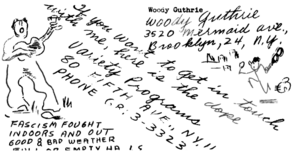
The years after the war, when Woody lived on Mermaid Avenue, were very creative for him. He wrote many songs and stories. His daughter Nora later kept these writings safe.
During this time, a young musician named Ramblin' Jack Elliott learned a lot from Woody. Elliott would visit Woody's home and watch him write and perform. Later, Bob Dylan also learned from Elliott, who had learned from Woody.
Deteriorating Health due to Huntington's Disease
By the late 1940s, Woody's health began to get worse. He started acting strangely. In 1952, doctors finally figured out he had Huntington's disease. This is a genetic illness he inherited from his mother. Because of his behavior, Marjorie suggested he move back to California without her. They later divorced.
As his health worsened, he married his third wife, Anneke Van Kirk. They had a child named Lorina Lynn. Woody's arm was hurt in an accident, and he could no longer play the guitar. Anneke later divorced him because it was too hard to care for him. Lorina Lynn was adopted by friends and died in a car accident at age 19. After this divorce, Marjorie, his second wife, came back into his life and cared for him until he died.
Woody was in hospitals from 1956 until his death in 1967. Marjorie and their children visited him every Sunday. His illness made it harder for him to control his muscles. By 1965, he could no longer speak.
Because of Woody's fame, his death from Huntington's disease helped people learn more about the illness. Marjorie helped start a group to fight Huntington's disease. None of Woody's three surviving children with Marjorie have developed the disease.
Folk Revival and Death
In the late 1950s and early 1960s, many young people were inspired by folk singers like Woody. This was called the American folk music revival. It focused on important issues like civil rights. Young Bob Dylan visited Woody in the hospital and looked up to him. Dylan said Woody's songs had "the infinite sweep of humanity in them."
Woody Guthrie died on October 3, 1967, from complications of Huntington's disease. His ashes were scattered at sea. By the time he died, a new generation had discovered his music through artists like Bob Dylan and Pete Seeger, and his own son, Arlo.
Personal Life
Woody Guthrie was married three times and had eight children:
- Mary Esta Jennings (married 1933; divorced 1943), three children:
* Gwendolyn Gail (1935–1976), had Huntington's disease. * Sue (1937–1978), also had Huntington's disease. * Bill (1939–1962).
- Marjorie Greenblatt Mazia (married 1945; divorced 1953), four children:
* Cathy Ann (1943–1947). * Arlo Davy Guthrie (1947–) * Joady Ben (1948–) * Nora Guthrie Rotante (1950–)
- Anneke van Kirk (married 1953; divorced 1954), one child:
* Lorina Lynn (1954–1973).
He is the grandfather of musician Sarah Lee Guthrie.
Musical Legacy
Woody Guthrie Foundation
The Woody Guthrie Foundation is a group that takes care of the Woody Guthrie Archives. These archives hold the largest collection of Woody's materials in the world. In 2013, the archives moved to the Woody Guthrie Center in Tulsa, Oklahoma.
The Woody Guthrie Center has a museum about Woody's life, music, writings, and art. The museum is open to the public. The archives are for researchers and contain thousands of items like original artwork, lyrics, and photos.
Many of Woody's unrecorded lyrics have been used for new albums. For example, the bands Wilco and Billy Bragg used his lyrics for their Mermaid Avenue albums. Other artists have also created music from his words.
WoodyFest Folk Festival
The Woody Guthrie Folk Festival, also called "WoodyFest," happens every year in mid-July. It celebrates Woody's life and music in his hometown of Okemah, Oklahoma. The festival aims to keep Woody's music alive.
A bronze statue of Woody Guthrie and his guitar stands in Okemah. His guitar has the famous message: "This machine kills fascists." The statue was put up in 1998, the first year of the festival.
Jewish Songs
Woody's second wife, Marjorie, was Jewish. Her mother, Aliza Greenblatt, was a famous Yiddish poet. Woody and Aliza became friends and talked about their art. Woody wrote many Jewish lyrics inspired by this friendship. He saw the struggles of Jewish people as similar to those of his own people from Oklahoma.
These lyrics were found later by his daughter Nora. A Jewish music group called The Klezmatics put them to music. Their album Wonder Wheel won a Grammy Award.
Tributes to Woody Guthrie
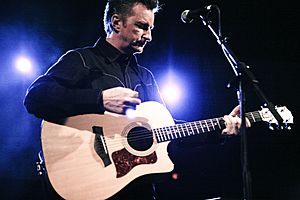
Many artists have honored Woody Guthrie by singing his songs or writing songs about him. In 1968, a few months after Woody died, a tribute concert was held in New York City. Famous performers like Jack Elliott, Pete Seeger, and Bob Dylan played. Another concert was held in 1970.
Irish folk singer Christy Moore was also inspired by Woody. Bruce Springsteen often sings "This Land Is Your Land" at his concerts. He called it "one of the most beautiful songs ever written."
In 1996, the Rock and Roll Hall of Fame held a conference about Woody Guthrie. Many musicians, including Arlo Guthrie and Bruce Springsteen, performed.
From 1999 to 2002, a traveling exhibit called This Land Is Your Land: The Life and Legacy of Woody Guthrie showed his life through objects, drawings, and recordings.
In 2003, Jimmy LaFave created a tribute show called Ribbon of Highway, Endless Skyway. Different singers performed Woody's songs and read his writings.
In 2007, a musical celebration honored Woody and Marjorie Guthrie. It raised money for the Huntington's Disease Society of America.
In the 2007 movie I'm Not There about Bob Dylan, a character named "Woody Guthrie" appears. This shows how much Dylan looked up to Woody.
Pete Seeger had a boat named the Sloop Woody Guthrie. It helps teach people about the Hudson River.
Woody Guthrie was inducted into the Rock and Roll Hall of Fame in 1988. He also received a Grammy Lifetime Achievement Award in 2000. His songs "Roll on Columbia" and "Oklahoma Hills" became official state folk songs.
In 1998, the United States Postal Service released stamps honoring Woody Guthrie and other folk musicians.
Every year, a Woody Guthrie Birthday Bash concert is held in New York City.
In 2006, The Klezmatics won a Grammy for their album Wonder Wheel, which used Woody's Jewish lyrics. In 2008, a live recording of Woody won a Grammy for Best Historical Album.
In 2012, for Woody's 100th birthday, new albums of his lyrics were released. There was also a big tribute concert in Oklahoma. The Grammy Museum and Songwriters Hall of Fame also held tributes.
In 2022, the Morgan Library & Museum in New York City had an exhibit about Woody Guthrie. Also in 2022, the band Dropkick Murphys released an album using Woody's unused lyrics. Woody's daughter Nora gave them access to his writings.
Selected Discography
- Dust Bowl Ballads (1940)
- Nursery Days (1951)
- Songs to Grow on for Mother and Child (1956)
- Bound for Glory (1956)
- Ballads of Sacco & Vanzetti (1960)
- Woody Guthrie Sings Folk Songs (1962)
- Hard Travelin' (1964)
- Library of Congress Recordings (1964)
- Columbia River Collection (1987)
- This Land Is Your Land, The Asch Recordings, Vol.1 (1997)
- Muleskinner Blues, The Asch Recordings, Vol.2 (1997)
- Hard Travelin', The Asch Recordings, Vol.3 (1998)
- Buffalo Skinners, The Asch Recordings, Vol.4 (1999)
- The Live Wire: Woody Guthrie in Performance 1949 (2007)
- My Dusty Road (2009)
- Woody at 100: The Woody Guthrie Centennial Collection (2012)
See also
 In Spanish: Woody Guthrie para niños
In Spanish: Woody Guthrie para niños
- List of songs by Woody Guthrie
- List of albums by Woody Guthrie
- List of peace activists


